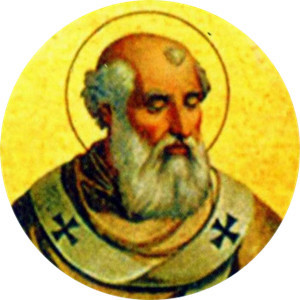
Saint Boniface, born Winfrid in the Devon town of Crediton, England, was a leading figure in the Anglo-Saxon mission to the Germanic parts of the Frankish Empire during the 8th century. He organised significant foundations of the Catholic Church in Germany and was made archbishop of Mainz by Pope Gregory III. He was martyred in Frisia in 754, along with 52 others, and his remains were returned to Fulda, where they rest in a sarcophagus which became a site of pilgrimage. Boniface's life and death as well as his work became widely known, there being a wealth of material available—a number of vitae, especially the near-contemporary Vita Bonifatii auctore Willibaldi, legal documents, possibly some sermons, and above all his correspondence. He became the patron saint of Germania, known as the "Apostle of the Germans".

Year 743 (DCCXLIII) was a common year starting on Tuesday of the Julian calendar. The denomination 743 for this year has been used since the early medieval period, when the Anno Domini calendar era became the prevalent method in Europe for naming years.
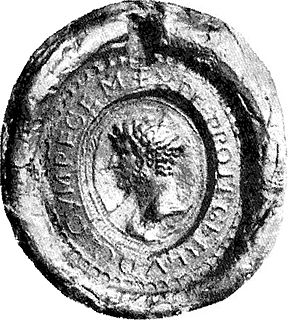
Ludwig "the German", also known as Ludwig II, was the first king of East Francia, and ruled from 843–876 AD. Grandson of emperor Charlemagne and the third son of Louis the Pious, emperor of Francia, and his first wife, Ermengarde of Hesbaye, he received the appellation Germanicus shortly after his death in recognition of Magna Germania of the Roman Empire, reflecting the Carolingian's assertions that they were the rightful descendants of the Roman Empire
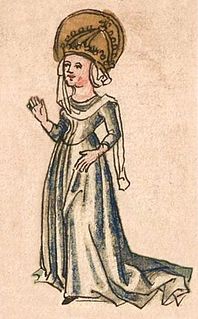
Hildegard, was a Frankish queen consort who was the second wife of Charlemagne and mother of Louis the Pious. Little is known about her life, because, like all women related to Charlemagne, she became notable only from a political background, recording her parentage, wedding, death, and her role as a mother.

Donar's Oak was a sacred tree of the Germanic pagans located in an unclear location around what is now the region of Hesse, Germany. According to the 8th century Vita Bonifatii auctore Willibaldi, the Anglo-Saxon missionary Saint Boniface and his retinue cut down the tree earlier the same century. Wood from the oak was then reportedly used to build a church at the site dedicated to Saint Peter. Sacred trees and sacred groves were widely venerated by the Germanic peoples.
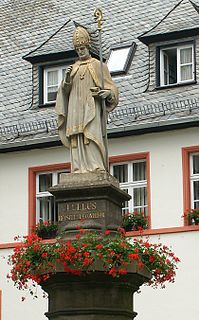
Saint Lullus was the first permanent archbishop of Mainz, succeeding Saint Boniface, and first abbot of the Benedictine Hersfeld Abbey.

Pepin the Short was the King of the Franks from 751 until his death. He was the first of the Carolingians to become king.
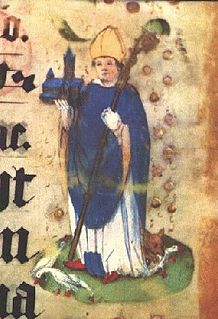
Saint Ludger was a missionary among the Frisians and Saxons, founder of Werden Abbey and first Bishop of Münster in Westphalia.
The title Duke [and Prince] of the Franks has been used for three different offices, always with "duke" implying military command and "prince" implying something approaching sovereign or regalian rights. The term "Franks" may refer to an ethnic group or to the inhabitants of a territory called Francia.
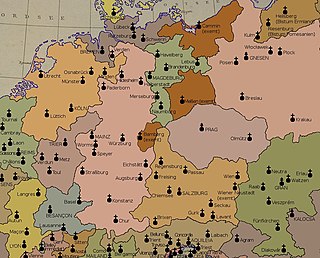
Primas Germaniae is a historical title of honor for the most important Roman Catholic bishop (Primate) in the German lands. Throughout the history of the Holy Roman Empire, it was claimed by the Archbishops of Mainz, Trier, Magdeburg and Salzburg alike. Actual prerogatives, however, were exercised by bishops holding the rank of an Apostolic legatus natus. While Mainz, Trier and Magdeburg lost the Primate dignity upon the 1648 Peace of Westphalia and the Napoleonic Secularisation in 1802, the Salzburg archbishops bear the title up to today.

The Lex Baiuvariorum was a collection of the tribal laws of the Bavarii of the sixth through eighth centuries. The first compilation was edited by Eberswind, first abbot of Niederaltaich, in 741 or 743. Duke Odilo, founder supplemented the code around 748. It is one of the most well documented bodies of Germanic tribal law.
The Council of Auxerre was a local church council which was important in illustrating customs both among the newly converted Teutonic tribes and their Gallo-Roman neighbours. They were held in the Ancient Diocese of Auxerre.
Theodor Schieffer was a German historian. He was professor of medieval history at the University of Mainz, then at the University of Cologne, and since 1952 he was president of the Association for Middle Rhine Church History. He is the author of Winfrid-Bonifatius und die christliche Grundlegung Europas, the authoritative biography of Saint Boniface.
Clement Scotus I was a bishop.
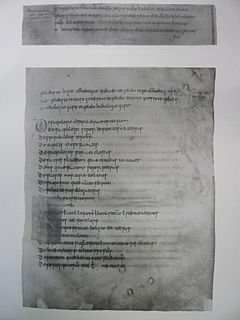
The Indiculus superstitionum et paganiarum is a Latin collection of capitularies identifying and condemning superstitious and pagan beliefs found in the north of Gaul and among the Saxons during the time of their subjugation and conversion by Charlemagne.
Michael Glatthaar is a German scholar of the Middle Ages, specializing in the documents of the Carolingians and the study of Saint Boniface. A student of Hubert Mordek, he is the author of Bonifatius und das Sakrileg (2004), a study of the saint's influence on the concept of sacrilege in the 8th-century church and afterward. In his study he identifies a number of sententiae in a Wurzburg manuscript as connected to Boniface, proposing the title Sententiae Bonifantianae Wirceburgensis for the fifty-four capitula and chapter headings in the manuscript. He has argued for the authenticity of the 716 capitulary of Pope Gregory II which invested three papal legates with the organization of the church in Bavaria, and for its close connection to Boniface's sphere of influence.



